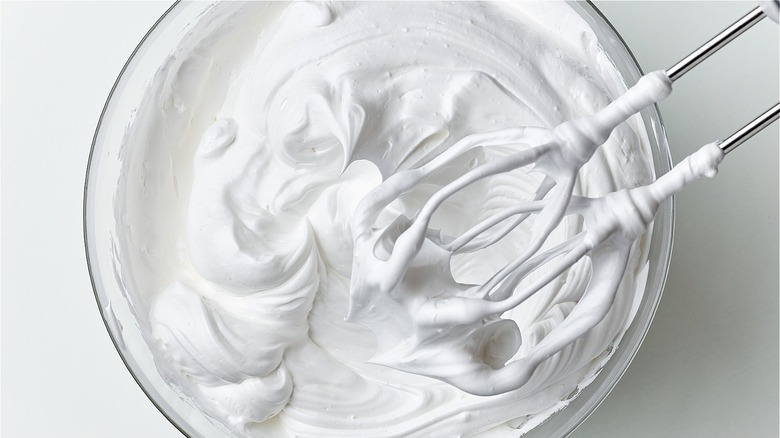Whipped Cream's Original Name Is So Cute
As Thanksgiving approaches, thoughts of course turn to the turkey that dominates the holiday table. But there's something else beyond the green bean casserole, cranberry sauce, and mashed potatoes and gravy that spurs Turkey Day anticipation. That, of course, is the Thanksgiving desserts — many of which are only complete when a swoosh of whipped cream is dolloped on top. And while today we often rely on the canned whipped cream in our refrigerator doors, this old-school topping far predates the arrival of the Pilgrims on the shores of America. Even if the Pilgrims had whipped cream (and there's no evidence that they did), it would have been vastly different from the fluffy delight we know today.
According to Food & Wine, whipped cream is found in Italian recipes from the mid-1500s and French recipes from the early 1600s, nearly two decades before the Pilgrims celebrated the first Thanksgiving. But those first whipped creams were just that: the high-fat layer found atop a container of milk, whipped into a froth by stirring it vigorously with a tree branch or plant stem. It wasn't until 1661 that sugar was added to whipped cream, done by the French chef Vatel in a reception recipe to honor King Louis XIV of France. Since then, there have been countless variations on crème fouettée — though whipped cream wasn't always the name of this signature sweet topping.
Whipped cream used to be known as milk snow
In its earliest incarnations, whipped cream wasn't called whipped cream. In Italy, according to Food & Wine, it was "neve di latte," and in France, it was "neige de lait," both of which mean "milk snow." The English also apparently likened whipped cream to snow; a 1545 recipe for the topping was called "A Dyschefull of Snowe" and augmented with egg whites and rosewater. Nearly five centuries following that "dishful of snow," most of us know whipped cream as a delicious pressurized froth, sometimes spewing straight into our open mouths.
For that canned, fun alternative to homemade whipped cream, the world owes thanks to Charles Getz, a Depression-era University of Illinois chemistry graduate student; George Frederick Smith, Getz's chemistry professor; and Aaron Lapin, a St. Louis dairy salesman turned inventor. Getz discovered that milk would become a foam if pumped full of carbon dioxide, which inspired him to compress whipped cream with nitrous oxide. Smith, working with his brothers, subsequently developed a system for putting whipped cream into returnable containers that could be sent back and forth from soda fountains and other places. Some years later, Lapin developed a lid and nozzle that would allow whipped cream to be stored in consumer-sized disposable canisters at high pressure, giving birth to Reddi-wip. Lapin's January 5 birthday — he died in 1999 at 85, according to CBS News — is recognized as National Whipped Cream Day.

